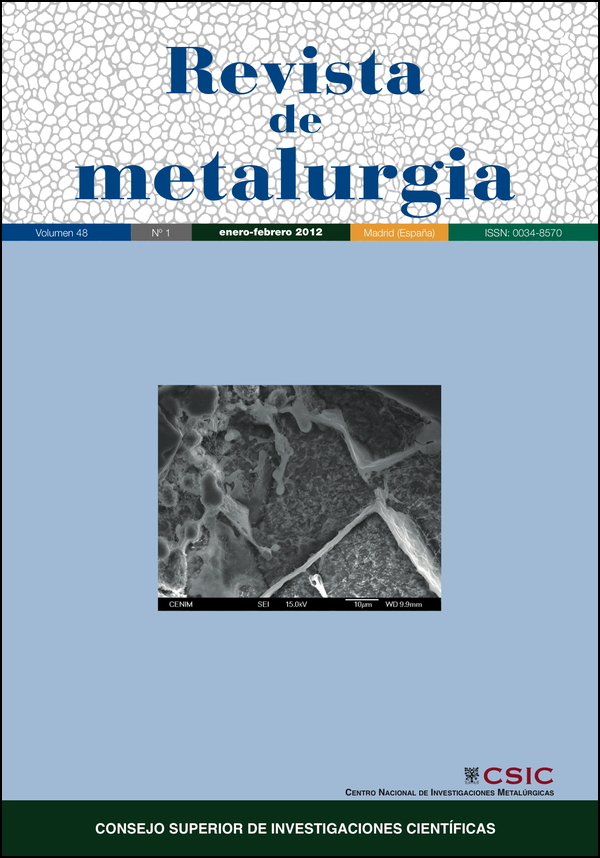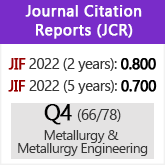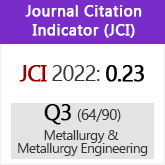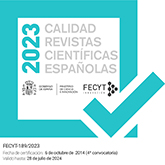A microencapsulation process of liquid mercury by sulfur polymer stabilization/solidification technology. Part I: Characterization of materials
DOI:
https://doi.org/10.3989/revmetalm.1133Keywords:
Mercury, Metacinnabar, Sulfur polymer stabilization/solidification (SPSS), Microencapsulation, Leaching, Mercury emissionAbstract
European Directives consider mercury a priority hazardous substance due to its adverse effects on human health and the environment. In response to environmental concerns, a microencapsulation process has been developed within the European LIFE program as a long-term storage option for mercury. This process leads to the obtainment of a stable concrete-like sulfur matrix that allows the immobilization of mercury. The final product, in the form of a solid block containing up to 30 % Hg, exhibits excellent mechanical properties (compressive strength 53-61MPa and flexural strength 7-10 MPa), low porosity (0.57 % PHe), very low total pore volume (0.63x10-2 cm3 g-1), and extremely low permeability (coefficient of water absorption by capillarity 0.07 g cm-2). Toxicity characteristic leaching tests reveal a mercury concentration in leachates well below the 0.2 mg L-1 set out in US EPA Land Disposal Restrictions (LDRs). The values of mercury vapor emissions of final products were lower than those of cinnabar and metacinnabar.
Downloads
References
[1] UNEP, Draft technical guidelines on the environmentally sound management of mercury wastes, 4th Draft, April, 2009. http://www.basel.int/techmatters/mercury/guidelines/040409.doc
[2] Directive 2000/60/EC of the European Parliament and of the Council of 23 October 2000 establishing a framework for Community action in the field of water policy, Official Journal. L 327, (22/12/2000), 0001-0073.
[3] Regulation (EC) No 1102/2008 of the European Parliament and of the Council of 22 October 2008 on the banning of exports of metallic mercury and certain mercury compounds and mixtures and the safe storage of metallic mercury, Official Journal of the European Union. L 304 (14/11/2008), pp. 75-79.
[4] T. Brasser. Mercury storage in Europe and Germany Regulations and General Conditions on “Mercury Storage Project Inception Workshop” Bangkok, Thailand, March 4-5. 2009. http://www.chem.unep.ch/mercury/storage/GRS-Germany%20T%20Brasser.pdf
[5] European Commission, Brussels, Requirements for facilities and acceptance criteria for the disposal of metallic mercury, Bipro, Final Report, 16, April, 2010.
[6] M. Svensson, B. Allard and A. Düker, Sci. Total Environ. 368 (2006) 418-423. http://dx.doi.org/10.1016/j.scitotenv.2005.09.040
[7] F.A. López, A. López-Delgado, I. Padilla, H. Tayibi and F.J. Alguacil, Sci.Total Environ. 408 (2010) 4341-4345. http://dx.doi.org/10.1016/j.scitotenv.2010.07.008 PMid:20673963
[8] e-CFR. 40 Protection of Environment. I Environmental Protection Agency. I Solid Wastes. Part 268 Land Disposal Restrictions, subpart D 268.42 Treatment standards expressed as specified technologies. http://cfr.vlex.com/vid/268-expressed-specified-technologies-19820104
[9] P. Randall and S. Chattopadhyay, J. Hazard. Mater. B114 (2004) 211-223. http://dx.doi.org/10.1016/j.jhazmat.2004.08.010 PMid:15511593
[10] R. Malviya and R. Chaudhary, J. Hazard. Mater. B137 (2006) 267-276. http://dx.doi.org/10.1016/j.jhazmat.2006.01.065 PMid:16530943
[11] J.M. Zhuang, T. Lo, T. Walsh and T. Lam, J. Hazard. Mater. B113 (2004) 157-164. http://dx.doi.org/10.1016/j.jhazmat.2004.06.003 PMid:15363526
[12] X.Y. Zhang, Q.C. Wang, S.Q. Zhang, X.J. Sun and Z.S. Shang, J. Hazard. Mater. 168 (2009) 1575-1589. http://dx.doi.org/10.1016/j.jhazmat.2009.03.050 PMid:19376646
[13] H. Vroom, Sulfur cements, process for making same and sulfur concretes made therefrom. Patent US 4058500 (1977).
[14] STARTcreteTM Technologies Inc. laboratory procedure for producing STARcretesTM test specimens. Tehnical Report, 2000.
[15] M.M. Jonhson, M. Simfukwe, G.P. Nowack and D.H. Kubiced, Patent US 5360632 (1994).
[16] P.D. Kalb, D. Melamed, B.R. Patel and M. Fuhrmann, Patent US 6399849 (2002).
[17] M. Fuhrmann, D. Relamed, P.D. Kalb, J.W. Adams and L.W. Milina. Waste Manage. 22 (2002) 327-333. http://dx.doi.org/10.1016/S0956-053X(01)00057-5
[18] F.A. López, A. López-Delgado, F.J. Alguacil and M. Alonso, Spanish Patent P200930672 (2009).
[19] A. López-Delgado, F.A. López, C. Pérez, F.J. Alguacil, A. Conde, M. Ramos and P. Higueras, 9th International Conference on Mercury as a Global Pollutant, Ghuizhou, China, 2009, pp.
[20] Real Decreto 2661/1998, de 11 de diciembre, por el que se aprueba la Instrucción Española del Hormigón Estructural (EHE), BOE num.11 (13/01/1999) 1525-1526.
[21] UNE EN 196-1:2005. Métodos de ensayo de cementos. Parte 1: Determinación de resistencias mecánicas, 2005.
[22] TCLP, EPA Method 1311. Toxicity Characteristic Leaching procedure, http://www.epa.gov/osw/hazard/testmethods/sw846/pdfs/1311.pdf
[23] EPA Method 7474. Mercury in sediment and tissues samples by atomic fluorescence spectrometry, http://www.epa.gov/osw/hazard/testmethods/sw846/pdfs/7474.pdf
[24] G.R. Darnell. Stabilization and Solidification of Hazardous, Radioactive, and Mixed Wastes, T. Michael Gillian and Carlton C. Willes (editors), vol. 3, American Society for Testing and Materials, West Conshohocken, PA, 1996, pp. 272-283.
[25] P.D. Kalb, J.W. Adams, M.L. Meyer and H.H. Burns, Stabilization and Solidification of Hazardous, Radioactive, and Mixed Wastes, T. Michael Gillian and Carlton C. Willes (editors), vol. 3, West Conshohocken, PA, 1996, pp. 327-340.
[26] US EPA Land Disposal Restrictions Regulations for Mercury-Containing Non-wastewater. http://www.epa.gov/osw/hazard/wastetypes/universal/lamps/faqs.htm
[27] Mercury Laws and Regulations. Land Disposal Restrictions Regulations for Mercury- Containing Waste. http://www.epa.gov/mercury/regs.htm#wastes
Downloads
Published
How to Cite
Issue
Section
License
Copyright (c) 2012 Consejo Superior de Investigaciones Científicas (CSIC)

This work is licensed under a Creative Commons Attribution 4.0 International License.
© CSIC. Manuscripts published in both the printed and online versions of this Journal are the property of Consejo Superior de Investigaciones Científicas, and quoting this source is a requirement for any partial or full reproduction.All contents of this electronic edition, except where otherwise noted, are distributed under a “Creative Commons Attribution 4.0 International” (CC BY 4.0) License. You may read here the basic information and the legal text of the license. The indication of the CC BY 4.0 License must be expressly stated in this way when necessary.
Self-archiving in repositories, personal webpages or similar, of any version other than the published by the Editor, is not allowed.


















